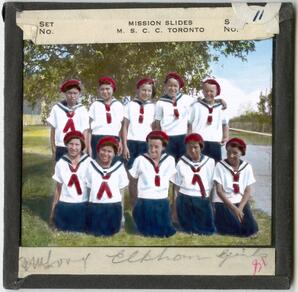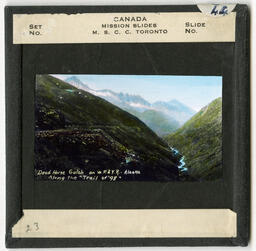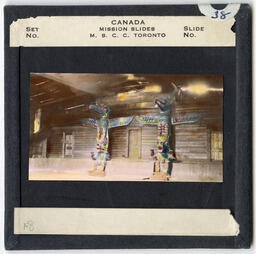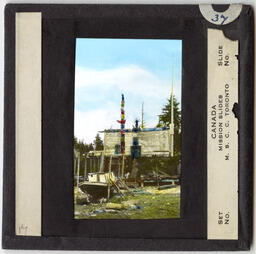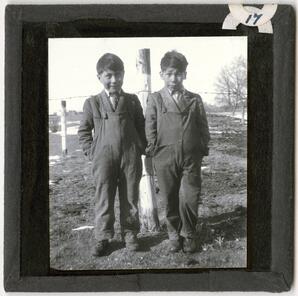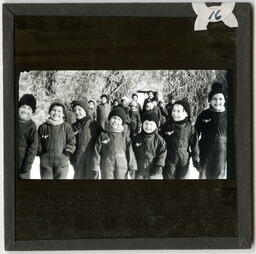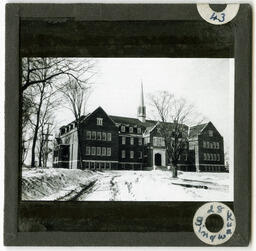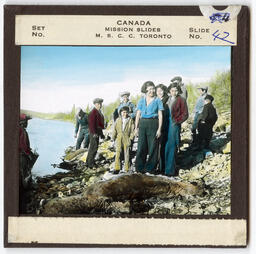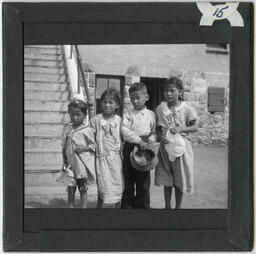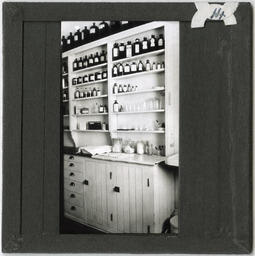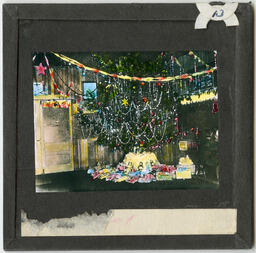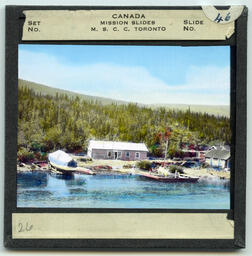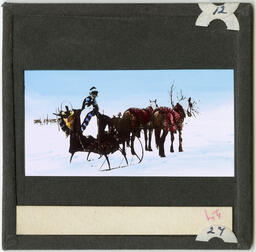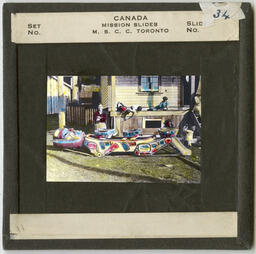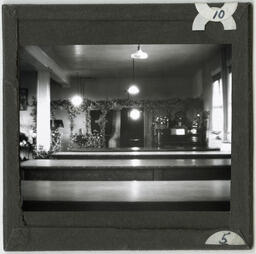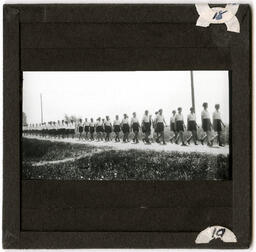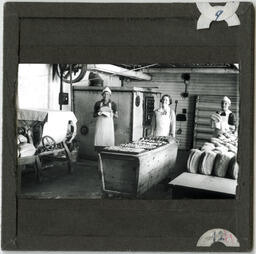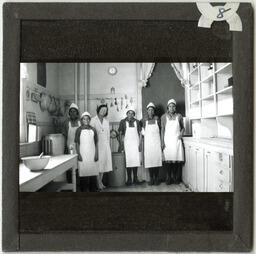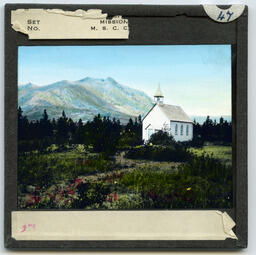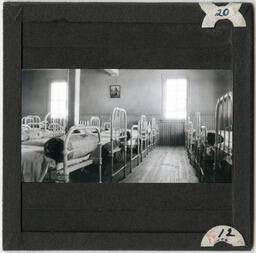Missionary Society of the Church of England in Canada
Related Works
Content type
Collection
Description / Synopsis
About the Collection: The Missionary Society of the Church of England in Canada (MSCC) Glass Lantern Slide Collection consists of 48 glass lantern slides, 29 of which are hand-tinted. The slides include images related to four Residential Schools: Elkhorn (Manitoba), St. Michael’s (British Columbia), Shingwauk (Ontario), and Choutla (Yukon). About Lantern Slides: Magic lantern slideshows were a common presentation tool used by Canadian churches in the late nineteenth and early twentieth centuries. Vivid, carefully chosen images were presented to congregations alongside commentary at church events, and served to summarize, justify, and raise funds for church mission work, including involvement with Residential Schools. These slides would have been projected to audiences by means of a gas-illuminated magic lantern, bringing dramatic emphasis to the church’s account of their work with Indigenous populations, while simplifying and typifying their subjects for broad public consumption. Collection Goals: Our goal in digitizing the MSCC Glass Lantern Slide Collection is to document the narrative the church constructed around the impact of its missionary work. While these representations of Residential Schools leave out much context — including the damaging cultural and emotional consequences they have had for Indigenous communities — viewing the collection can contribute to a more complete understanding of the tools that were used to convince congregations of the value of Residential Schools, while obscuring the harm they caused. We hope the collection can be used to support learning about Residential Schools both locally and beyond.
Origin Information
Content type
Image
Description / Synopsis
Landscape. According to annotations, photograph was taken in Dead Horse Gulch on the White Pass & Yukon Route Railway, Alaska, along the "Trail of '98"
Origin Information
Content type
Image
Description / Synopsis
The inside of a building with two totems. Based on the original order of the collection, photograph might have been taken in Alert Bay.
Origin Information
Content type
Image
Description / Synopsis
Totem with a building in the background and a boat in the foreground with low tide. Based on the original order of the collection, photograph might have been taken in Alert Bay.
Origin Information
Content type
Image
Description / Synopsis
Two children in a field. Based on the original order of the collection, photograph might have been taken at Elkhorn (Washakada) Residential School. The Elkhorn Residential School started as the Washakada Home for Girls and the Kasota Home for Boys were established in the village of Elkhorn, MB in 1888. Following a fire, the school was rebuilt outside the town in 1895. Ongoing financial problems led to a government takeover of the school. It was closed in 1918 but reopened in 1923, under the administration of the Anglican Church’s Missionary Society. Many students came from northern Manitoba. The leaders of The Pas Indian Band made a number of complaints about the conditions at the school, which was eventually closed in 1949. (National Centre for Truth and Reconciliation)
Origin Information
Content type
Image
Description / Synopsis
Twenty one children in Winter clothes by a building. Based on the original order of the collection, photograph might have been taken at Elkhorn (Washakada) Residential School. The Elkhorn Residential School started as the Washakada Home for Girls and the Kasota Home for Boys were established in the village of Elkhorn, MB in 1888. Following a fire, the school was rebuilt outside the town in 1895. Ongoing financial problems led to a government takeover of the school. It was closed in 1918 but reopened in 1923, under the administration of the Anglican Church’s Missionary Society. Many students came from northern Manitoba. The leaders of The Pas Indian Band made a number of complaints about the conditions at the school, which was eventually closed in 1949. (National Centre for Truth and Reconciliation)
Origin Information
Content type
Image
Description / Synopsis
Waterfront village. Based on the original order of the collection, photograph might have been taken near Alert Bay.
Origin Information
Content type
Image
Description / Synopsis
Winter view of the main school building in Shingwauk Residential School, Sault Ste. Marie, Ontario. The Shingwauk school opened in 1873 in Garden River, ON, burning down within days of opening. It was replaced two years later with a school built near Sault Ste. Marie. In 1931 the school was condemned. A new school opened in 1935, at which time the school merged with the Wawanosh girls’ school. In the 1950s Shingwauk students began attending local day schools. In 1969 the federal government took over the administration of the school, closing it the following year. The former school is home to Algoma University College and the Shingwauk Project Residential School Archive and Research Centre. (National Centre for Truth and Reconciliation). Item is a duplicated of item no. 1030, fonds 008 Missionary Society of the Church of England in Canada (MSCC) fonds, from the Anglican Church of Canada General Synod Archives.
Origin Information
Content type
Image
Description / Synopsis
Twelve people by the shore with hunted animals. Based on the original order of the collection, photograph might have been taken near Alert Bay.
Origin Information
Content type
Image
Description / Synopsis
Four children by the entrance of a building. Based on the original order of the collection, photograph might have been taken at Elkhorn (Washakada) Residential School. The Elkhorn Residential School started as the Washakada Home for Girls and the Kasota Home for Boys were established in the village of Elkhorn, MB in 1888. Following a fire, the school was rebuilt outside the town in 1895. Ongoing financial problems led to a government takeover of the school. It was closed in 1918 but reopened in 1923, under the administration of the Anglican Church’s Missionary Society. Many students came from northern Manitoba. The leaders of The Pas Indian Band made a number of complaints about the conditions at the school, which was eventually closed in 1949. (National Centre for Truth and Reconciliation)
Origin Information
Content type
Image
Description / Synopsis
Dispensary cabinet. Based on the original order of the collection, photograph might have been taken at Elkhorn (Washakada) Residential School. The Elkhorn Residential School started as the Washakada Home for Girls and the Kasota Home for Boys were established in the village of Elkhorn, MB in 1888. Following a fire, the school was rebuilt outside the town in 1895. Ongoing financial problems led to a government takeover of the school. It was closed in 1918 but reopened in 1923, under the administration of the Anglican Church’s Missionary Society. Many students came from northern Manitoba. The leaders of The Pas Indian Band made a number of complaints about the conditions at the school, which was eventually closed in 1949. (National Centre for Truth and Reconciliation)
Origin Information
Content type
Image
Description / Synopsis
Christmas tree with presents in the corner of a room with decorations. There are two sitting children visible in the corner of the photograph.
Origin Information
Content type
Image
Description / Synopsis
Landscape with the Choutla Residential School, Carcross, Yukon. Item is a duplicated of item no. 875, fonds 008 Missionary Society of the Church of England in Canada (MSCC) fonds, from the Anglican Church of Canada General Synod Archives. In 1903 students from the school at Forty Mile, Yukon, were moved to a small school in Carcross. In 1911 the federal government built the Choutla school. The school had a reputation for poor health, harsh discipline, poor food, and unpleasant living quarters. In the 1940s, the principal admitted to strapping students so severely that they had to be held down. The school burned down in 1939 and was rebuilt in 1944. A new school was built in 1953. It closed in 1969. (National Centre for Truth and Reconciliation)
Origin Information
Content type
Image
Description / Synopsis
Sleigh with one person on top and two horses on the front.
Origin Information
Content type
Image
Description / Synopsis
Ten girls dressed up with the Girl Guides' uniform. According to annotation on the slide, photograph was taken at Elkhorn (Washakada) Residential School. The Elkhorn Residential School started as the Washakada Home for Girls and the Kasota Home for Boys were established in the village of Elkhorn, MB in 1888. Following a fire, the school was rebuilt outside the town in 1895. Ongoing financial problems led to a government takeover of the school. It was closed in 1918 but reopened in 1923, under the administration of the Anglican Church’s Missionary Society. Many students came from northern Manitoba. The leaders of The Pas Indian Band made a number of complaints about the conditions at the school, which was eventually closed in 1949. (National Centre for Truth and Reconciliation)
Origin Information
Content type
Image
Description / Synopsis
Carver with a feast dish in front of a house. There are five children and one adult in the background. Based on the original order of the collection, photograph might have been taken in Alert Bay.
Origin Information
Content type
Image
Description / Synopsis
Room with Christmas decorations. Room seems to be the same as the one described as the dining room at Elkhorn Residential School, item no. 897 fonds 008 Missionary Society of the Church of England in Canada (MSCC) fonds, from the Anglican Church of Canada General Synod Archives. The Elkhorn Residential School started as the Washakada Home for Girls and the Kasota Home for Boys were established in the village of Elkhorn, MB in 1888. Following a fire, the school was rebuilt outside the town in 1895. Ongoing financial problems led to a government takeover of the school. It was closed in 1918 but reopened in 1923, under the administration of the Anglican Church’s Missionary Society. Many students came from northern Manitoba. The leaders of The Pas Indian Band made a number of complaints about the conditions at the school, which was eventually closed in 1949. (National Centre for Truth and Reconciliation)
Origin Information
Content type
Image
Description / Synopsis
Street with five totems. According to annotations, photograph was taken in Alert Bay.
Origin Information
Content type
Image
Description / Synopsis
Approximately 40 children walking in line. Based on the original order of the collection, photograph might have been taken at Elkhorn (Washakada) Residential School. The Elkhorn Residential School started as the Washakada Home for Girls and the Kasota Home for Boys, which were established in the village of Elkhorn, MB in 1888. Following a fire, the school was rebuilt outside the town in 1895. Ongoing financial problems led to a government takeover of the school. It was closed in 1918 but reopened in 1923, under the administration of the Anglican Church’s Missionary Society. Many students came from northern Manitoba. The leaders of The Pas Indian Band made a number of complaints about the conditions at the school, which was eventually closed in 1949. (National Centre for Truth and Reconciliation)
Origin Information
Content type
Image
Description / Synopsis
Three women in a bakery at Elkhorn Residential School. Two of the women are holding baked goods and the third is pushing a cart with baked goods. Item is a duplicated of item no. 04, fonds 301 The Provincial and Diocesan Synods of the Anglican Church of Canada collection, from the Anglican Church of Canada General Synod Archives. The Elkhorn Residential School started as the Washakada Home for Girls and the Kasota Home for Boys were established in the village of Elkhorn, MB in 1888. Following a fire, the school was rebuilt outside the town in 1895. Ongoing financial problems led to a government takeover of the school. It was closed in 1918 but reopened in 1923, under the administration of the Anglican Church’s Missionary Society. Many students came from northern Manitoba. The leaders of The Pas Indian Band made a number of complaints about the conditions at the school, which was eventually closed in 1949. (National Centre for Truth and Reconciliation)
Origin Information
Content type
Image
Description / Synopsis
Six people. One of them seems to be the kitchen matron with five of her staff at one end of the kitchen at Elkhorn (Washakada) Residential School. Item is a duplicated of item no. 902, fonds 008 Missionary Society of the Church of England in Canada (MSCC) fonds, from the Anglican Church of Canada General Synod Archives.
Origin Information
Content type
Image
Description / Synopsis
Church. Based on the rest of the collection and general aspect, photograph might have been taken in Carcross, Yukon and the church might be the St. Saviour's Anglican church. Item is similar to item no. P 166, fonds 365 Henry Hooper Marsh family fonds, from the Anglican Church of Canada General Synod Archives.
Origin Information
Content type
Image
Description / Synopsis
Glass lantern slide of a dormitory. Based on the original order of the collection, photograph might have been taken at Elkhorn (Washakada) Residential School. The Elkhorn Residential School started as the Washakada Home for Girls and the Kasota Home for Boys, which were established in the village of Elkhorn, MB in 1888. Following a fire, the school was rebuilt outside the town in 1895. Ongoing financial problems led to a government takeover of the school. It was closed in 1918 but reopened in 1923, under the administration of the Anglican Church’s Missionary Society. Many students came from northern Manitoba. The leaders of The Pas Indian Band made a number of complaints about the conditions at the school, which was eventually closed in 1949. (National Centre for Truth and Reconciliation)
Origin Information
Content type
Image
Description / Synopsis
Approximately fifty people in front of a van. According to annotations, photograph is of a Tuberculosis Clinic at Elkhorn (Washakada) Residential School. The Elkhorn Residential School started as the Washakada Home for Girls and the Kasota Home for Boys, which were established in the village of Elkhorn, MB in 1888. Following a fire, the school was rebuilt outside the town in 1895. Ongoing financial problems led to a government takeover of the school. It was closed in 1918 but reopened in 1923, under the administration of the Anglican Church’s Missionary Society. Many students came from northern Manitoba. The leaders of The Pas Indian Band made a number of complaints about the conditions at the school, which was eventually closed in 1949. (National Centre for Truth and Reconciliation)
Origin Information
Content type
Image
Description / Synopsis
Woman, two children, and a dog in front of a house. Based on the original order of the collection, photograph might have been taken at Elkhorn (Washakada) Residential School. The Elkhorn Residential School started as the Washakada Home for Girls and the Kasota Home for Boys were established in the village of Elkhorn, MB in 1888. Following a fire, the school was rebuilt outside the town in 1895. Ongoing financial problems led to a government takeover of the school. It was closed in 1918 but reopened in 1923, under the administration of the Anglican Church’s Missionary Society. Many students came from northern Manitoba. The leaders of The Pas Indian Band made a number of complaints about the conditions at the school, which was eventually closed in 1949. (National Centre for Truth and Reconciliation)
Origin Information

